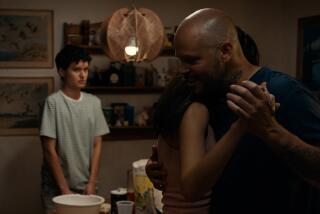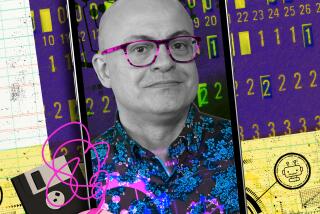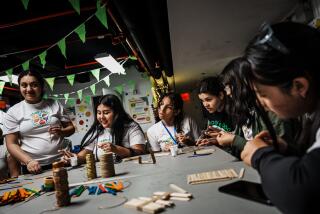Spooky new cartoon ‘Victor and Valentino’ channels Mesoamerican folklore
Victor and Valentino are half-brothers who couldn’t be more different, but they both have a knack for awakening the ancient evils from Mesoamerican folklore.
The brothers, who are spending the summer with their Grandma Chata in a pretty little town called Monte Macabre, will be getting into all kinds of spooky trouble in “Victor and Valentino,” Cartoon Network’s new animated supernatural adventure series that debuted Saturday in both the U.S. and Latin America.
Created by Diego Molano, “Victor and Valentino” is a fun, inclusive take on the classic odd-couple setup with the brothers getting into various antics as they learn to appreciate each other’s quirks and differences.
Molano — who previously worked on the shows “The Powerpuff Girls,” “Black Dynamite,” “Superjail!” and “China, IL” — first started drawing Victor and Valentino in 2002 for his thesis project as a student at the Maryland Institute College of Art. In that incarnation, the brothers were a part of a video game. But that isn’t the only difference between Molano’s original idea and the new animated show.
“Back then it used to be three brothers,” said Molano. “It was Victor, Valentino and Vicente. And it was kind of like a cooperative video game where they all had different attributes and you had to work together to get tasks done.”
After working a few years in architecture, Molano eventually moved out to Los Angeles. While interning at the animation studio Titmouse, Molano revisited the brothers to pitch the TV show.
From the Mesoamerican mythical figures the brothers encounter to the Spanish that is seamlessly incorporated into the dialogue, “Victor and Valentino” wears its Latin American roots proudly.
And Molano is excited his show is finally putting the spotlight on Aztec, Olmec and Mayan mythologies because not a lot of people are familiar with these stories.
“There’s never really been Mesoamerican folklore-based movies or shows or anything in popular culture,” said Molano.
The show especially stands out because diversity studies show year after year that Latinos and other minorities remain underrepresented in Hollywood movies and television. In fact, only 6.2% of the top scripted broadcast TV roles in 2017 were Latino.
“It’s about time that we have more representation,” said Molano. “Not just Latinx, but every culture. America is made of every culture, that’s the cool thing about America. It’s all of us. And the indigenous peoples of America, they’ve been kind of buried in history, so it’s cool to bring some of that back to life.”

Molano has always been drawn to Mesoamerican folklore and credits his grandfather with sparking his interest in the pre-Hispanic, indigenous mythologies of the Americas when he was a kid.
“When I was growing up, he would tell me all these really unbelievable stories and a lot of it had to do with mysticism and folklore,” said Molano. “He introduced me to mythology at a very, very early age.
“Because I was so fascinated with mythology, all my artwork had to do with mythology,” he added. And the more art he created, the more he delved into the subject.
Despite his familiarity with the folklore, Molano admits that adapting these stories into a cartoon was a bit of a challenge.
“It’s not easy to take the mythology and form it into something that works as an 11-minute short for children,” said Molano. “It’s very difficult but it’s really cool. That’s the fun part for me — taking something really dense to create a story line that you can follow.”
Another part of the challenge is making sure the show doesn’t veer too far into creepy elements because a lot of the myths can get pretty scary.
In addition to serving as showrunner, Molano also voices Victor in both the English and Spanish versions of the show.
Although he voiced the character in the original 2016 pilot for Cartoon Network, Molano said initially he planned on finding another actor to voice Victor for the series so he could focus on running the show.
“But as I auditioned more people, I realized it would have taken me a lot longer to coach someone into the minutia and the little quirks that Victor has than to just do it myself,” said Molano.
He explained that Victor is heavily based on the kind of kid he was growing up. That’s partly why he tries to make sure Victor (and sometimes Valentino) learn a lesson at the end of each episode.
“It’s just cool to have Victor learn from his mistakes and learn his lessons, which is something that I would have liked to have learned more of growing up,” said Molano.
Victor is the more mischievous and impulsive brother who is not the most adept at spelling. Valentino is a bit more responsible and seems to be more mature, but he has a tendency to overreach that often backfires.
Although Vicente was phased out back when Molano was putting together the show’s pitch for Cartoon Network, “Victor and Valentino” is packed with a strong cast of supporting characters, including the dark and mysterious Charlene, the stern and often sweaty shop keeper Don Jalapeño and his tough teenage daughter, Xochi.

But among the standouts is Victor and Valentino’s charming and occasionally scary abuela, who appears to be blind but is not at all inhibited from living a full life complete with friends, romantic interests and even a rival.
“Grandma Chata is based on my grandmother,” said Molano. “When you did something wrong, you heard it. But then when you did something right, she loved you. But you never knew which grandma you were going to get.”
Ultimately, Molano hopes that Latinx kids will be able to see aspects of themselves in “Victor and Valentino” and feel proud.
“Having a small little cartoon TV show is a baby step in having Latinos feel like they’re part of this tapestry that’s America,” said Molano. “We’ve got a long way to go, but it’s a little step forward.”
Twitter: @tracycbrown
More to Read
The biggest entertainment stories
Get our big stories about Hollywood, film, television, music, arts, culture and more right in your inbox as soon as they publish.
You may occasionally receive promotional content from the Los Angeles Times.











